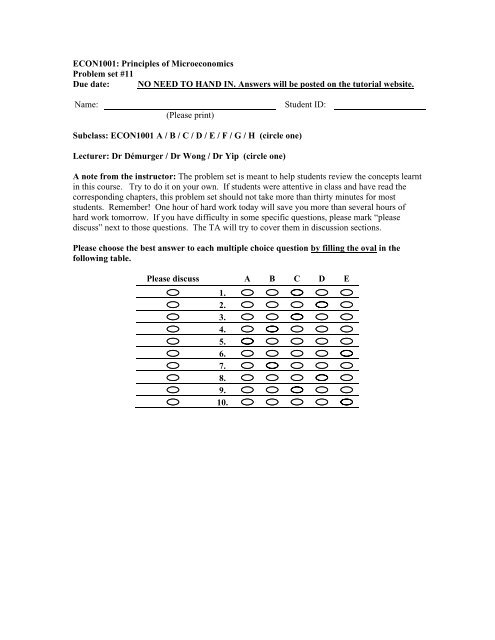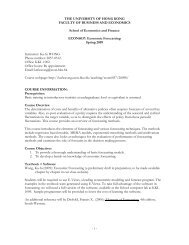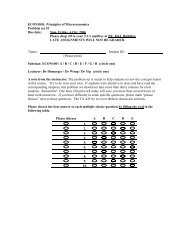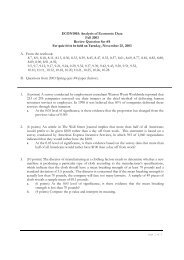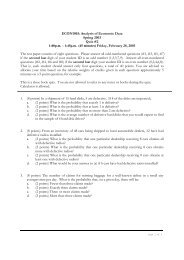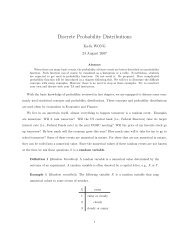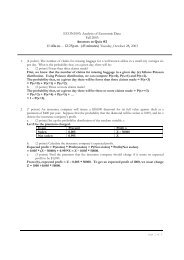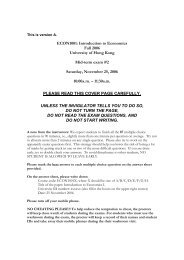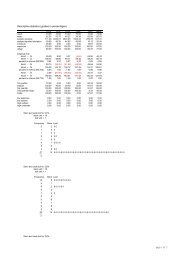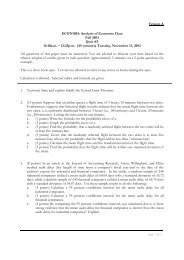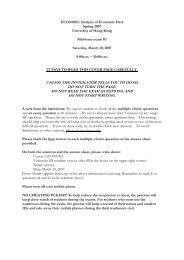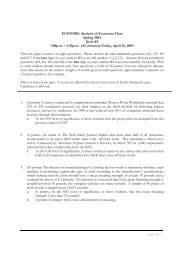Problem set #11 - Ka-fu Wong
Problem set #11 - Ka-fu Wong
Problem set #11 - Ka-fu Wong
- No tags were found...
You also want an ePaper? Increase the reach of your titles
YUMPU automatically turns print PDFs into web optimized ePapers that Google loves.
ECON1001: Principles of Microeconomics<strong>Problem</strong> <strong>set</strong> <strong>#11</strong>Due date: NO NEED TO HAND IN. Answers will be posted on the tutorial website.Name:(Please print)Student ID:Subclass: ECON1001 A / B / C / D / E / F / G / H (circle one)Lecturer: Dr Démurger / Dr <strong>Wong</strong> / Dr Yip (circle one)A note from the instructor: The problem <strong>set</strong> is meant to help students review the concepts learntin this course. Try to do it on your own. If students were attentive in class and have read thecorresponding chapters, this problem <strong>set</strong> should not take more than thirty minutes for moststudents. Remember! One hour of hard work today will save you more than several hours ofhard work tomorrow. If you have difficulty in some specific questions, please mark “pleasediscuss” next to those questions. The TA will try to cover them in discussion sections.Please choose the best answer to each multiple choice question by filling the oval in thefollowing table.Please discuss A B C D E1.2.3.4.5.6.7.8.9.10.
Do not hand in this question paper. ECON1001 <strong>Problem</strong> Set <strong>#11</strong>1. Which factor, if it were present, would lessen the ability of the Coase Theorem to solve anexternality?A) The situation is already efficient.B) Negotiating requires hiring a lawyer.C) The parties are all self-interested.D) The potential gain in surplus is high.E) Property rights have already been assigned to one of the parties.Use the following to answer questions 2:Suppose there are ten people playing cards in a room. One of them wants to smoke a cigar; nine of themdislike the smell of cigar smoke. The smoker values the privilege of smoking at $5, and each of the othernine occupants of the room would be willing to pay fifty cents for clean air in the room. The rulesgoverning use of the room state that smoking is not allowed unless everyone agrees to allow smoking.2. If the cigar smoker paid each other occupant fifty cents for the right to smoke, the cigar smokerwould be ______ and the other occupants would be _______.A) better off; worse off.B) better off; just as well off as before the payment.C) better off; better off.D) just as well off as before the payment; better off.E) worse off; just as well off as before the payment.Use the following to answer questions 3:Paul owns a home on the top of a hill and enjoys an unobstructed view of a large wooded area. The viewwas a large factor in his decision to buy the house and Paul values his view at $5,000 per month. Sidpurchases the undeveloped wooded area with plans to build a retail shopping center. Sid expects to earn$10,000 a month from the shopping center, which is $3,000 more than his next best alternative.3. Suppose Paul has offered to pay Sid $3,500 per month to cease development. If Sid accepts Paul'soffer, it wouldA) make Paul worse off and Sid better off. D) generate deadweight loss.B) make both Paul and Sid better off. E) make Paul better off and Sid worse off.C) make both Paul and Sid worse off.Use the following to answer questions 4-5:Curly and Moe are considering living alone or being roommates for the next twelve months. A onebedroom, one bath apartment is $500 per month while a two bedroom, one bath apartment is $800. Theone difficulty they have is that Moe snores very loudly. Curly estimates the cost of poor sleep due to Moe'ssnoring at $150 per month. Moe could obtain a snore-eliminating device for $50 per month.4. The least costly solution to the external cost is forA) Curly to endure Moe's snoring. D) Moe to find a fellow snorer to live with.B) both to live alone. E) Moe to pay Curly for his discomfort.C) Moe to eliminate his snoring.5. Assume that Curly and Moe choose to divide the change in the surplus from living togetherequally and apply it to their monthly rent payments. As a result, Moe will pay __________ permonth in rent and Curly will pay __________ per month in rent.A) $425; $425 D) $375; $425B) $400; $400 E) Neither amount can be determined.C) $350; $450- 1 -
Do not hand in this question paper. ECON1001 <strong>Problem</strong> Set <strong>#11</strong>Use the following to answer questions 6-8The following data show the relationship between the number of drivers who leave for work at 8:00 am,their average commute times, and their marginal benefit associated with the commute times.Number of driversthat leave at 8:00amAverage commutetime to downtown100 30 minutes $10200 65 minutes $8300 110 minutes $4400 170 minutes $3500 260 minutes $1MarginalBenefit6. If the highway is viewed as having a zero price, one can predict that __________ drivers willleave for downtown at 8:00 am.A) 500 B) 400 C) 300 D) 200 E) 1007. Suppose a toll is imposed in the following way: leaving between 8am and 9 am costs $5 perdriver, after 9 am the toll is zero. One can predict that __________ drivers will be on the roadbetween 8:00 and 9:00 am.A) 100 B) 200 C) 300 D) 400 E) 5008. The reason drivers would prefer building new roads to a $5 toll to reduce commute times isbecauseA) building roads is the only solution.B) they know a toll would not alter commuting behavior.C) cities always need new roads.D) the cost of new roads falls on all taxpayers; the toll only falls on those who use the existingroad.E) of the commitment problem.Use the following to answer questions 9-10:Suppose that in most car accidents between cars of unequal size, the smaller car sustains the most damageand its occupants suffer the most injury. In answering the following questions, assume that, on average,smaller cars generate less air pollution and that every person in the economy must drive at least one car.9. Relative to driving an average car, driving a larger-than-average car generates __________ anddriving a smaller-than-average car generates ________.A) an external cost; an external benefit.B) an external benefit; an external cost.C) an external cost; neither an external benefit nor an external cost.D) an external cost; an external cost.E) neither an external cost nor an external benefit; an external benefit.10. As the average size of cars increases, the incentive to buy a smaller carA) also increases due to cost savings at the <strong>fu</strong>el pump.B) also increases to off<strong>set</strong> the external cost of air pollution.C) decreases because of the increased risk of injury in an accident.D) remains the same because car purchases depend on individual preferences.E) decreases because automakers will have to charge a higher price for them.- END -- 2 -


